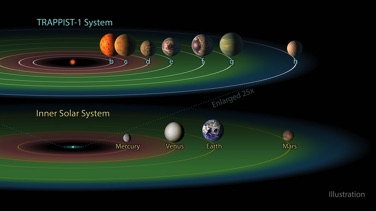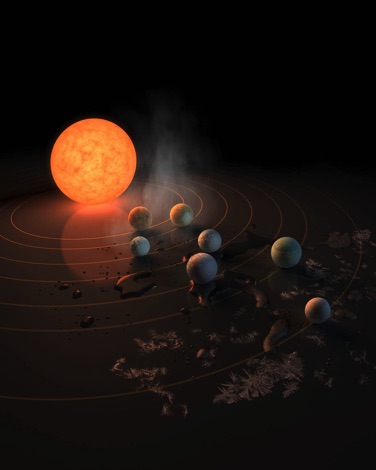Extrapolating the numbers we have today, astronomers estimate that our galaxy could be home to 40 billion Earth-sized planets, 11 billion of them orbiting Sun-like stars! The TRAPPIST-1 system discovery also proved that dim red dwarf stars are also viable hosts for Earth-like planets. This is particularly exciting because red dwarf stars like TRAPPIST-1 far outnumber stars like our Sun.
Many exobiologists believe that the sustained presence of liquid water is necessary for Earth-type life to be possible on an exoplanet. At reasonable atmospheric pressures, stable liquid water occurs between about 0° and 100° Celsius (32° to 212° Fahrenheit). If the orbit of an exoplanet around its host star keeps it close enough for water to avoid freezing, yet not hot enough to boil it away, it’s considered to orbit within the star’s habitable zone.
The habitable zone for our Sun extends from Venus’ orbit almost out to Mars. To avoid overheating an exoplanet, the habitable zones of hot stars have to be farther from the star, so the planet’s year will be longer. But hot stars live fast and die young – some as short as tens of millions of years – probably too short to allow time for life to originate and evolve. Cool stars, especially red dwarfs, shine for hundreds of billions of years. Their habitable zones are compact, and there is plenty of time for life to arise. Unfortunately, orbiting closer to a star also exposes a planet to increased harmful radiation, and space weather events like flares and coronal mass ejections.
Finally, the mass of the planet must be sufficient to exert enough gravitational attraction to hold on to a protective atmosphere, and volatiles like water. Mars is not large enough to have kept its atmosphere and water for long, resulting in its cold, dry state today. It’s not surprising then that scientists talk about “The Goldilocks Zone” for extra-terrestrial life. The planet has to be large enough, not too hot, and not too cold – just right, for life!

